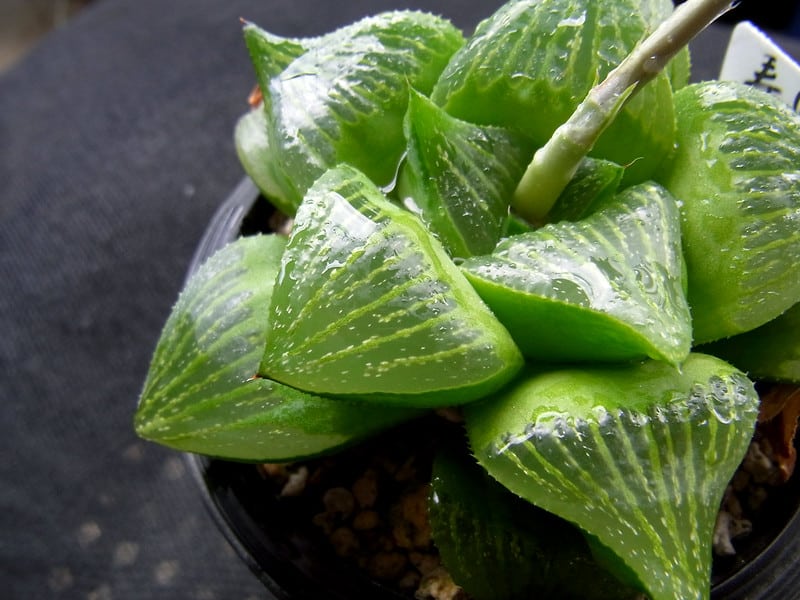The Haworthia retusa “Star Cactus” are small succulent plants with short, compact rosettes in the form of a star, which can produce and form groups of little children.
The leaves have a variable shape (ovate, deltoid or triangular) and can be light green, dark green or bright green and have translucent areas on the recurved tips.
The flowers do not have much ornamental interest since they are very small, white and arise in long floral stems that reach up to 30 cm in height.
Another characteristic of this plant is that if it is placed in full sun, the plant will take on a very beautiful reddish hue.
These plants are usually used in pots wider than tall as indoor plants, on the terrace or the balcony.
Although Haworthia retusa can live in full sun exposure, it is better to place the plant in semi-shade or with sifted light.
Haworthia retusa “Star Cactus” can thrive in various types of soil, but prefer a specific substrate for cacti and succulents to which some coarse sand will be added, to help with the drainage of the substrate.
You may like kalanchoe beharensis
Tips to care for the Haworthia retusa “Star Cactus”
Substratum
This plant tolerates a wide range of soils and habitats, but they prefer a very porous potting mix to increase drainage.
A non-acidic soil is ideal.
You can grow a plant in a 10-15 cm pot for years and have perfectly happy plants, since this plant is slow growing.
Illumination
The plant needs a good exposure to the sun so that its leaves grow compactly.
With a little exposure to the sun, the leaf develops a pleasant reddish color and remains compact. The ideal lighting for this plant is a semi-shade.
Irrigation
During the summer months, watering should be frequent, they should only prevent the plant from staying very dry, or that it is excessively humid.
During the winter months, you should only water when the soil becomes completely dry. Since, moist soil quickly causes root and stem rot, especially during the winter months.
By waiting for the substrate to be completely dry before the next irrigation, we protect the plant from root rot and fungus formation.
Temperature
This plant withstands the cold well, but so that the plant can grow perfectly, the temperature cannot drop below 10 ºC, since if the temperature is too low, the plant can die.
Fertilizer
Although this plant does not need a fertilizer to grow, it is good to add fertilizer to nourish the plant and grow much better. Ideally, buy a special fertilizer for cacti and succulents, and follow the instructions on the packaging.
This plant thanks a subscriber with a mineral fertilizer for succulent plants during the spring and during the fall.
Transplant
Due to the slow growth, this plant does not require such a frequent transplant.
The plant must be transplanted every 2 to 4 years.
Propagation
Haworthia reinwardtii can spread in a very simple way.
You should only use a sharp knife or scissors and make a cut as close as possible to the stem stem, including as many roots as possible, and make it a clean cut (no part of the root remains on the mother plant).
Then let the cutting rest for 2 days so that the wound becomes calloused, before sowing.
Then place the cuttings in a small pot, using the same soil as the mother plant, placing it in a warm and bright place.
Be sure to water properly. Keep the substrate moist until the cutting begins to take root, just avoid watering the cutting directly to prevent the leaf from publishing.
Propagation by seeds:
The best time to plant this plant is in spring. You should only use a small pot and add a special substrate for cacti and succulents with good drainage.
Then spread the seeds on top of the substrate, and add a very light layer of substrate to the seeds.
Keep the substrate moist (but avoid waterlogging), and keep the pot in a place where it receives good sunlight.
Once the plant is ripe and suitable for manipulation, it can be transplanted into a definitive pot.
Pruning
This plant does not need to be pruned. Only remove the leaves that are battered or dry, so that the plant looks better.
Plagues and diseases
The main problem that can affect your plant is excess water. Since, this can cause the roots of the plant to rot, and can also cause fungal formation.
These plants can also be attacked by mealybugs. If the plant is attacked by this pest, it is best to buy a special fertilizer for these types of pests.
